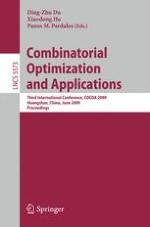2009 | Book
Combinatorial Optimization and Applications
Third International Conference, COCOA 2009, Huangshan, China, June 10-12, 2009. Proceedings
Editors: Ding-Zhu Du, Xiaodong Hu, Panos M. Pardalos
Publisher: Springer Berlin Heidelberg
Book Series : Lecture Notes in Computer Science
